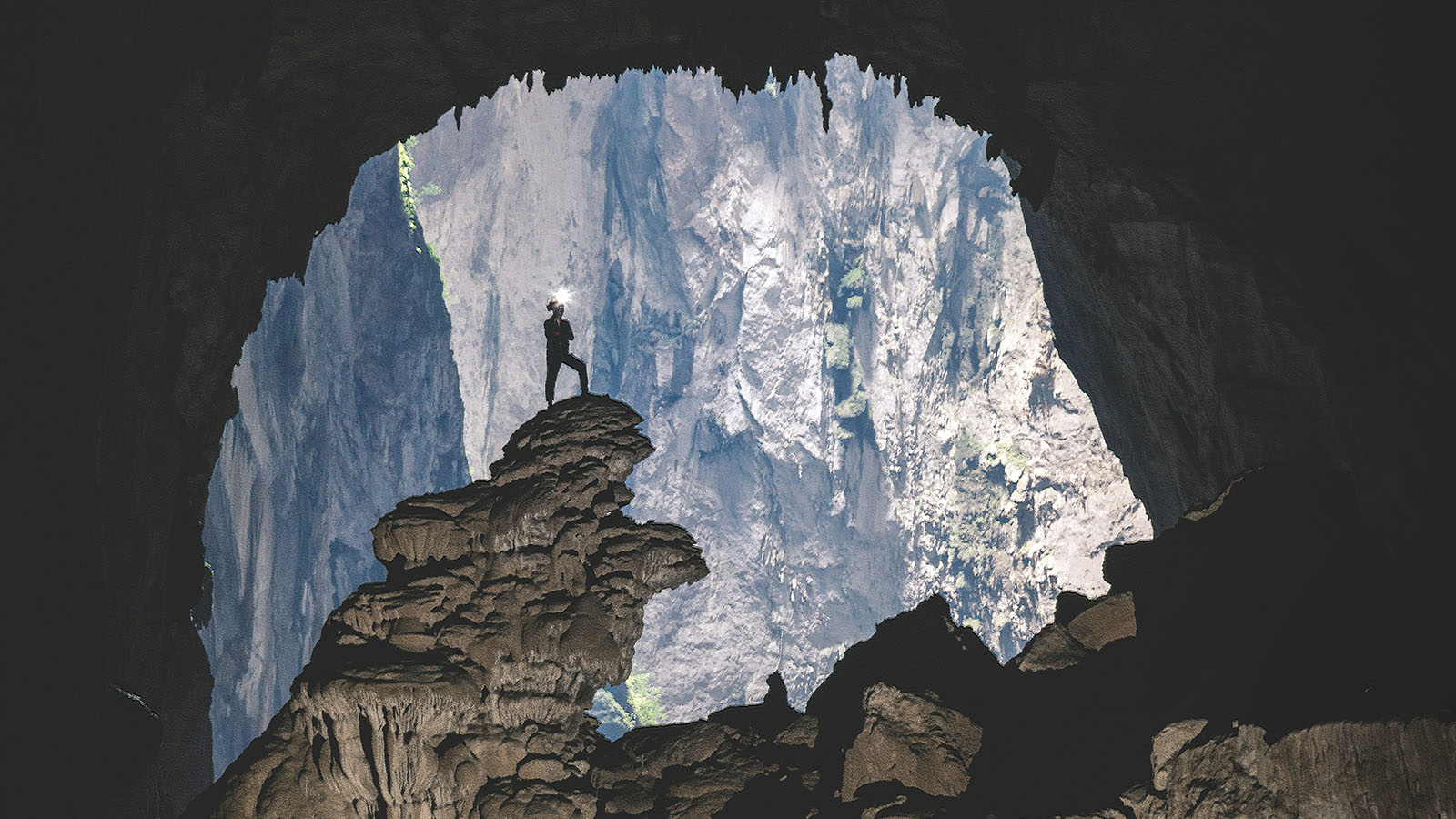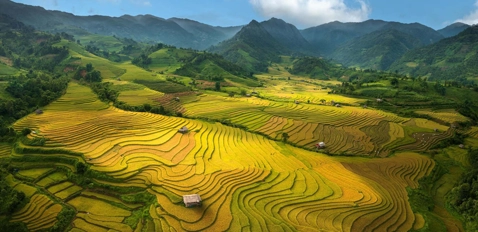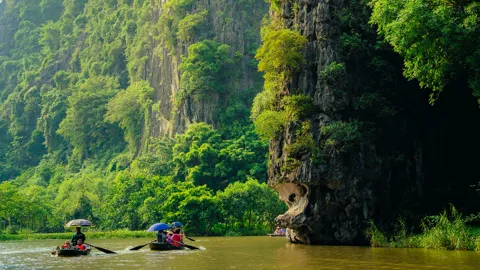How to get to Ba Be Lake from Hanoi, Ha Giang, and Cao Bang
Ba Be Lake is one of the most peaceful and scenic places in northern Vietnam. Located in Ba Be National Park, Bac Kan Province, the lake sits about 240 km north of Hanoi. It is surrounded by limestone mountains, tropical forest, caves, waterfalls, and traditional villages of the Tay, Hmong, and Dao people. The lake itself is the largest natural freshwater lake in Vietnam and has a calm, wild beauty that makes it perfect for a quiet escape.
If you’re planning a visit and wondering how to get to Ba Be Lake, this guide will walk you through the best travel options from Hanoi, Ha Giang, and Cao Bang. We’ll go over distances, transport types, pros and cons, prices, and a few honest tips to help you prepare.
How to get to Ba Be Lake?
From Hanoi
Ba Be Lake is about 230 kilometers north of Hanoi. It usually takes 5.5 to 7 hours, depending on the type of transportation and road conditions.
By car
You can rent a private car or van with a driver. This is the most comfortable and flexible option.
Time: 5.5 to 6.5 hours
Price: $120–$150 one way for a 4-seater car; more for larger vehicles
Pros:
-
Door-to-door service
-
Stops along the way
-
Best for groups or families
Cons:
-
Expensive for solo travelers
-
Not ideal if you’re on a budget
Tip: If you have motion sickness, bring medication. The road through Bac Kan can be winding.
By bus
This is a good option for budget travelers. There are a few bus companies that go directly to Ba Be or stop in Bac Kan City.
Time: 6 to 7.5 hours
Price: $8–$15 one way
How to do it:
-
Take a bus from Hanoi (My Dinh or Gia Lam station) to Bac Kan City
-
From Bac Kan, transfer to a minibus or taxi to Ba Be Lake (50–60 km more)
Pros:
-
Cheap
-
Easy to find tickets
Cons:
-
Multiple transfers
-
Limited comfort
By train
There is no direct train to Ba Be Lake. The closest train station is in Thai Nguyen City, but it’s still far from the lake.
Why it’s not recommended:
-
You’ll need to take a train from Hanoi to Thai Nguyen (2.5 hours), then find a bus or taxi to Bac Kan (2 hours), then continue to Ba Be
-
The journey becomes complicated and long
Our advice: Skip the train for this route
Advice
If you value comfort and don’t mind the cost, book a private car. If you’re on a budget and don’t mind longer travel, take the bus. Avoid the train, it adds too many steps and delays.
From Ha Giang
Ba Be Lake is located about 210 kilometers from Ha Giang City. This route runs through some remote but beautiful mountain areas. The journey usually takes 6 to 8 hours, depending on your transport and road conditions.
By Private Car
This is the easiest and most direct option.
Time: 6 to 7 hours
Price: $120–$140 for a one-way trip in a 4-seater car
Pros:
-
No need to change vehicles
-
More comfortable than public transport
-
You can stop along the way to take photos or eat
Cons:
-
Expensive for solo travelers
-
Some roads are narrow and bumpy
Tip: If you’re traveling with friends, splitting the cost makes this option much more affordable. Ask your accommodation in Ha Giang to help arrange a trusted driver.
By Motorbike
If you’re already doing the Ha Giang Loop, you can continue south to Ba Be by motorbike. The road between Bao Lac (part of the Loop) and Ba Be is a common connection.
Time: 6 to 8 hours
Cost: ~$10/day for bike rental + fuel
Pros:
-
Total freedom
-
Incredible scenery
-
Great for adventurers
Cons:
-
Long ride
-
Some parts of the road are in poor condition
-
Risky in bad weather or if you’re not experienced
Tip: Leave early and avoid riding after dark. Watch for landslides or potholes, especially after rain.
By Bus
There is no direct public bus from Ha Giang to Ba Be Lake. You’ll need to break the journey into two parts:
1. Ha Giang to Bac Kan City or Thai Nguyen
2. Bac Kan/Thai Nguyen to Ba Be Lake
Time: Around 9 to 11 hours total
Price: $10–$20 depending on the route and connections
Pros:
-
Cheap
-
Safer than motorbike if you're unsure about riding
Cons:
-
Multiple transfers
-
Hard to find up-to-date schedules
-
May have long waiting times
Tip: If you're serious about this route by bus, go through a local travel agency or ask your guesthouse in Ha Giang to help with the connections.
Advice
If you’re coming from Ha Giang and you want an easy journey, hire a private car. It’s the only direct and comfortable option. If you’re riding a motorbike and confident on rough roads, the route is scenic and memorable, but it’s not for beginners. Public buses are the cheapest but also the most complicated. You’ll lose time on transfers and waiting, and it’s not great for people with limited days.
From Cao Bang
Ba Be Lake is about 120 kilometers from Cao Bang City. This is the shortest route among the three cities we’re covering. The journey usually takes 3.5 to 5 hours, depending on your vehicle and the road conditions.
This route goes through winding mountain roads, but the views are stunning. You’ll pass through remote villages, rice fields, and forested hills. If you’re planning a northern Vietnam loop that includes Ban Gioc Waterfall, Ba Be Lake is a natural next stop.
By Private Car
This is the easiest and most comfortable way to get from Cao Bang to Ba Be.
Time: 3.5 to 4.5 hours
Price: $70–$100 for a 4-seater car (one way)
Pros:
-
Fast and direct
-
Comfortable
-
Good choice if you’re carrying luggage
Cons:
-
More expensive than public options
-
Not always available without booking ahead
Tip: Ask your hotel in Cao Bang to help book a car. They usually know reliable drivers. If you’re traveling with others, this becomes a very reasonable option when split.
By Motorbike
If you enjoy adventure and riding mountain roads, this is a great route.
Time: 4 to 5 hours
Cost: ~$10/day for rental, plus gas
Pros:
-
Beautiful scenery
-
Freedom to stop in villages and viewpoints
-
Makes the trip feel like a journey, not just a transfer
Cons:
-
Winding and steep in places
-
Risky in bad weather
-
Physically tiring if you’re not used to riding long distances
Tip: The route from Cao Bang to Ba Be via Tinh Tuc and Cho Ra is scenic but challenging. Only ride if you’re confident in your skills and your bike is in good condition.
By Bus
There is no direct bus from Cao Bang City to Ba Be Lake, but you can make it work with some effort.
Option 1: Through Cho Ra
Step 1: Take a local bus or minivan from Cao Bang to Cho Ra
Step 2: From Cho Ra, take a taxi or motorbike to Ba Be Lake (about 20 km)
Total time: 5 to 6 hours
Total cost: Around $10–$15
Option 2: Through Bac Kan City
Step 1: Take a bus from Cao Bang to Bac Kan City
Step 2: Continue from Bac Kan to Ba Be by local minivan or taxi
Total time: 6 to 7 hours
Total cost: Around $12–$18
Pros:
-
Budget-friendly
Cons:
-
Time-consuming
-
Schedules not always reliable
-
You’ll probably have to wait between transfers
Tip: If you choose the bus route, leave early in the morning. Services are limited in the afternoon, and it’s better to arrive at Ba Be before dark.
Advice
Cao Bang to Ba Be is one of the more manageable legs in the northern Vietnam circuit. If you can afford a private car, this route is quick and smooth. If you're already traveling by motorbike, the road offers a great ride with lots of natural beauty. Public buses are doable but involve some effort and patience. Try to plan ahead and stay flexible.
Things to do around Ba Be Lake
1. Boat Trip on Ba Be Lake
A boat tour is the best way to see the lake and its surroundings. You’ll cruise through calm waters, limestone cliffs, and small rivers.
Route highlights:
-
Puong Cave: A large cave where the Nang River flows through
-
An Ma Temple: A small temple on an island
-
Dau Dang Waterfall: At the southern end of the lake
-
Cost: From 500,000 to 1,000,000 VND per boat, depending on the route and number of passengers
Tip: You can join a group or arrange a private boat through your homestay. Early morning is best for quiet and misty views.
2. Visit Puong Cave
Puong Cave is a tall cave carved by the Nang River. It’s full of bats, stalactites, and cool air — perfect on a hot day. The boat will usually stop here.
-
You don’t need special gear
-
Can be slippery, so wear good shoes
-
The cave is not too long, but it’s worth seeing for the scale and atmosphere
3. Trekking to Minority Villages
You can hike through Tay, Dao, and Hmong villages near the lake. Some common trekking routes include:
Ba Be – Pac Ngoi – Coc Toc – Na Nghe
Ba Be – Dau Dang Waterfall – Hua Ma Cave
Time: Half-day to full-day treks
Difficulty: Easy to moderate
Tip: Go with a local guide. They can explain the culture and help you not get lost.
4. Stay in a Homestay
The best way to experience Ba Be is to stay in a traditional stilt house. Most are run by Tay ethnic families.
Popular villages: Pac Ngoi, Coc Toc
Price: 150,000–300,000 VND per night, including meals in many cases
Why it’s worth it:
-
Home-cooked meals
-
Peaceful atmosphere
-
A chance to learn about local life
Tip: Don’t expect luxury, but you’ll get warm hospitality and great views.
5. Explore Hua Ma Cave
Located about 6 km from Ba Be Lake, Hua Ma is one of the most impressive caves in the region. You’ll need to climb stairs to reach the entrance, but the large chambers and formations inside are worth it.
Entrance fee: Around 25,000 VND
Bring a flashlight: Parts of the cave are dimly lit
Combine it with a motorbike ride or trek
6. Bike Around the Lake
Some homestays rent out bicycles or motorbikes. Riding around the lake gives you freedom to explore at your own pace.
Road conditions: Some rough patches, but manageable
What to see: Villages, rice fields, riverside paths, forest viewpoints
7. Try Local Food
The Tay people serve simple but delicious dishes using local ingredients. Common foods include:
-
Grilled fish from the lake
-
Bamboo shoots
-
Sticky rice
-
Corn wine
Tip: Most homestays offer dinner and breakfast. These are often better and more authentic than the few restaurants in the area.
Itinerary
Day 1: Hanoi - Ba Be Lake
Morning:
Leave Hanoi early (around 7:00 AM).
You can:
-
Hire a private car (most direct and comfortable – takes ~5.5 hours).
-
Take a bus to Bac Kan, then transfer to a minivan or taxi to Ba Be (total ~6–8 hours).
Midday:
Lunch in Bac Kan town or Cho Ra (last town before the park).
Afternoon:
Arrive at Pac Ngoi Village or Coc Toc Village (by 2:00–4:00 PM).
Check in to a local homestay with views of the lake or rice fields.
Evening:
Stroll around the village or walk down to the lake.
Enjoy a home-cooked dinner with your host family.
Optional: Try corn wine or join in simple local music if your host arranges it.
Day 2: Explore Ba Be Lake and Surroundings
Morning:
After breakfast, take a boat trip on Ba Be Lake (3–4 hours):
-
Visit An Ma Temple, Puong Cave, and Dau Dang Waterfall.
-
Stop for tea at a riverside hut or local home if the boatman suggests it.
Afternoon:
Return to the homestay for lunch.
In the afternoon, choose one:
-
Light trekking to nearby Tay or Hmong villages.
-
Visit Hua Ma Cave by motorbike or bicycle.
-
Rent a bicycle and ride along quiet roads.
Evening:
Relax, watch the sunset over the lake.
Have another local dinner.
Chat with your host, or just enjoy the calm. Electricity is limited in some areas, so don’t expect nightlife.
Day 3: Ba Be Lake - Hanoi
Morning:
Have an early breakfast.
Optional: quick walk to the lake or a short village visit.
8:00–9:00 AM: Start heading back to Hanoi.
If using a private car, you’ll be back in the city by mid-afternoon.
If taking a public bus, expect to reach Hanoi in the late afternoon or early evening.
Evening: You’ll arrive back in Hanoi, hopefully refreshed and ready for the next leg of your trip.
Conclusion
Ba Be Lake may not be as famous as places like Sapa or Halong Bay, but it offers a different kind of experience — one that’s slower, quieter, and more connected to nature and local life. Getting there takes some planning, but the journey is worth it once you arrive. You’ll find clear water, forest-covered mountains, and kind-hearted people ready to welcome you into their homes.
If you're still unsure how to get to Ba Be Lake or want someone to handle the details, you can consider booking a guided tour. Many tours include transport, boat rides, homestays, and local guides — making your visit smoother and more enjoyable.
>>> Map of Cao Bang: Your essential travel guide to the majestic borderland
>>> What to do in Ba Be Lake and Cao Bang for 4 days?
Send us your comments about : How to get to Ba Be Lake from Hanoi, Ha Giang, and Cao Bang
Required fields *
You might also be interested
Travel ideas
Need some inspiration? Discover some of the best tours in Vietnam, which are highly appreciated by our clients. An excellent starting point to help you choose the right trip to Vietnam, Laos, Cambodia, Burma or Thailand, whether you are traveling alone, as a couple, as a family or with friends.
And because this trip is yours, feel free to customize it as you wish!
Vietnam Cambodia Itinerary 14 Days
Hanoi – Hoa Binh – Mai Chau – Ninh Binh – Halong bay – Hue - Danang – Hoian – Saigon – Ben Tre - Can Tho – Saigon - Siem Reap Angkor - Tonlé Sap - Siem Reap – Ta Prohm - Departure
Vietnam 14 Day Itinerary
Vietnam 14-day itinerary covers the country’s top highlights and quintessential experiences for an unforgettable journey.
Honeymoon Tour Pakcages In Vietnam 12 Days
Saigon Arrival - City Tour – Mekong Delta – Danang – Hoian - by flight - Da Nang – Hanoi - by flight – Halong - overnight on junk – Departure
Authentic Hoang Su Phi Trekking Tours
Hoang Su Phi trekking tours take you to stunning terraces, meet few tourists, connect with locals and enjoy authentic culture.
Best Nha Trang Beach Tour 4 Days
Saigon/Hanoi – Nha Trang relaxation – Saigon/Hanoi – Departure
Mekong Delta Bike Tour Itinerary 7 Days
Cycle through the Mekong Delta in 7 days, discovering floating markets, orchards, craft villages, and tranquil green islands.
Are you interested in this tour?




























Comment